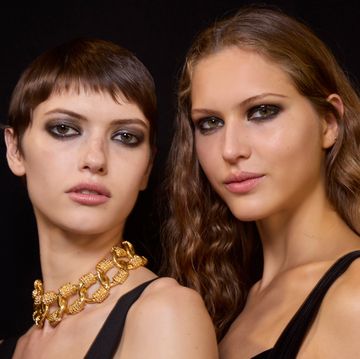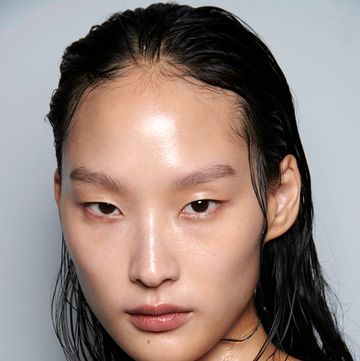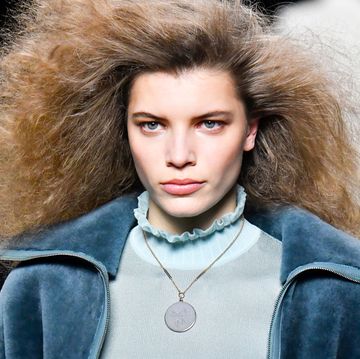The first time someone commented on the density of my hair, I was 24, getting a haircut. "It's so thin!" the stylist exclaimed. "I know," I said, shrugging as if this weren't a big deal, even as it prompted a feeling akin to terror. According to the American Academy of Dermatology, forty percent of American women experience some hair thinning by 40, but most of us don't like to talk about it. Instead, we quietly spend $1.4 billion a year on treatments —many of which don't work—meant to make our strands less sparse. The stylist suggested I buy an expensive shampoo, but I didn't. How, I wondered, could a shampoo change my scalp?
The second time someone said something was a few weeks before I got married, at age 31. I had gone to a salon with my mom to try to figure out how to wear my hair at the wedding, but after 15 minutes the stylist became frustrated. "There's just not much to work with," she said. "Oh, that's my fault," my mom jumped in, spotting the stricken look on my face. "I have fine hair too."
It turns out the idea that thinning hair among women is necessarily genetic is just one of many widespread assumptions that are either up for debate or downright wrong. (Exhibit A? That it's passed down through your mother's genes.) Even the theory that having certain genes means you're doomed to lose your hair is now being challenged by epigenetics research, which explores the once-heretical notion that there could be ways to alter the way genes are expressed. And yes, a shampoo can definitely change your scalp. Daily use of a one percent zinc shampoo (hair is mostly composed of protein, and zinc, when absorbed through the scalp, likely helps the body synthesize it) leads to "modest and sustained improvement in hair growth," according to a 2003 clinical study published in the British Journal of Dermatology.
The life cycle of a single hair involves a growth phase of around four years, a brief transitional period as the strand is cut off from its blood supply, then a months-long resting phase, at the end of which, ideally, it's pushed out by a new hair. For people dealing with genetic hair loss, the growth phase is shortened and some of the new hair comes in finer, but genes are only one of many reasons women might lose hair. Follicles can be damaged by hair pulled too tight; thinning can also be caused by stress, nutritional deficiencies, and thyroid problems. Figuring out what kind of loss you're dealing with—by going to a dermatologist—is key in knowing how to treat it. The dramatic shedding that can occur after giving birth, for example, results from hormonal changes (women lose little hair while pregnant and afterward shed the excess they've retained) and generally resolves on its own.
As far as my hair, its composition shifted significantly after I gave up gluten—soon, a halo of new tendrils appeared. "Eating gluten could have kept your body from absorbing the nutrients it needed to grow hair," L.A.-based dermatologist Glynis Ablon, MD, says. A few months after I went gluten-free, dermatologist Sejal Shah examined my scalp under a microscope that magnified my hairs to forestlike proportion. "It's better to seek help sooner rather than later," she said, because if a follicle stays dormant for too long it loses the ability to produce new hair. However, while follicles are still producing strands, even small ones, they can be coaxed back into a healthier state with various treatments, the most popular being a product that includes the active ingredient minoxidil, the only FDA-approved topical drug for hair growth.
Scientists still don't entirely understand how minoxidil works, but research suggests it prompts quiescent follicles back into the growing phase and keeps them there longer. For women who'd rather not take a drug, though, other products that range from supplements to serums purport to achieve the same effect. The researchers behind Viviscal, a supplement that's long been an open secret in the fashion world ("Models pop it like Pez," beauty blogger Narcissista writes), claim their blend of deep-sea fish proteins nudges resting follicles awake, as do numerous other lines, such as ReTress, from Las Vegas dermatologist Candace Spann. And in Europe topicals are already available that supposedly prompt growth through stimulating stem cells—though none have yet been approved by the FDA.
Also promising is low laser light technology—a 2014 American Journal of Clinical Dermatology study found that an at-home laser helmet prompted "significantly greater hair density" in those who used it compared with the control group after 24 weeks. "We think one day, just like people have a hair dryer at home, they'll have one of these devices," says NASA scientist turned beauty entrepreneur Tamim Hamid (he describes himself as "100 percent geek"). Hamid's Theradome, the first laser helmet to be FDA-cleared for over-the-counter sale, is designed to be worn 20 minutes twice a week and utilizes red low-level lasers to stimulate cell mitochondria, spurring growth. (U.S. dermatologists have offered in-office laser treatments for 13 years, but the twice- or thrice-weekly sessions cost upward of $100 each and aren't covered by insurance.)
When my helmet arrives in the mail, I discover it closely resembles headwear worn in the original Tron. Once I put it on, the 80 lasers light up automatically and a robotic voice informs me of the minutes remaining in my session. It's not quite Siri: "Session aborted," it informs me loudly when I jostle it in my bag the night I bring it home on the subway.
Sometimes, though, you want both long-term treatment and immediate results. With this in mind, one rainy afternoon I meet with Philip Berkovitz, the L.A.-based hair-care whiz behind the luxury line Philip B, whose volumizing shampoos and oil treatments have a cult following. Tall, prone to speed talking, and long a proponent of the circulation-boosting benefits of scalp massage, he scours the world for hard-to-find ingredients. Origin stories for his products are apt to begin: "I was working on the princesses of Kuwait, and they were like, Oh my God, you need to experience katira and I said what's katira and they said it's a natural plant gum from Iran, so they took me to the souk and then they took me to their house. Which is the palace…."
As he applies his peppermint-and-avocado shampoo to my hair, roughly massages my head, then pulls up my strands into a triangle that makes me look like the Grinch, he tells me about his new product, called simply Hair Growth System, which he's releasing this spring. It employs niacin and caffeine to prompt circulation, as well as high concentrations of a compound made from stabilized polyphenols said to not only stimulate stem cells but activate fibroblasts, which aid in collagen production (beyond reducing wrinkles, collagen also helps microvessels deliver nutrients to hair follicles). "They're in a lot of high-end skin care," Berkovitz says about fibroblasts, still talking a mile a minute. "It's usually taken from, believe it or not, foreskins." (I look this up afterward—the man was not mistaken.)
I find myself thinking about the long, strange history of balding cures. A papyrus from ancient Egypt suggests crushing a donkey tooth in honey and applying the concoction to one's head. Rubbing the scalp with animal dung was widely recommended until the 1700s. To consider this is to question which of our current solutions will one day seem impossibly odd. It's also to wonder how many folk remedies might have been onto something. A "miracle ageing brew" from England, for example, included red clover, now frequently used in topicals and supplements for thinning hair; Berkovitz's peppermint shampoo alone contains 16 different plant extracts.
As I walk to the train I notice that my hair, after being rinsed, conditioned, and blown out, is sleek and thick. It has perhaps never felt so thick. Clearly, we are beginning to stumble upon some satisfying answers to this age-old concern. And who knows? Maybe someday I'll drip a serum onto my follicles only to discover that it was actually sourced, in some not even too distant way, from a donkey tooth crushed in honey. Maybe it will work like a charm.
By row, from left to right
Theradome's 80 low-level laser lights stimulate cell mitochondria, triggering dormant follicles to grow new hairs; theradome.com
L'Oreal Paris Advanced Haircare Volume Filler Fiber Amplifying Concentrate temporarily boosts the diameter of each hair strand , and effects last through five shampoos. $6; drugstore.com
Kérastase Densifique Minoxidil Hair Regrowth Treatment for Women is clinically proven to create new growth. $139; amazon.com
Earth's Nectar Mint Leaves Scalp Oil, meant for curly hair, uses a combination of peppermint and rosemary to stimulate follicles when applied twice daily to the scalp. $19; sephora.com
Hairstylist Jen Atkin looks to throwback thickening treatment Barry's Tricopherous to increase hair density and length. $13; ebay.com
Philip Kingsley Trichotherapy Tricho Pro Volumizing Protein Spray Hair Density Formula strengthens hair with elastin to prevent breakage. $70; lookfantastic.com
Retress Conditioner uses natural oils, licorice extract, and a tripeptide complex to soothe scalp inflammation, reduce hair breakage, and nourish follicles. $24; sephora.com
This article appears in the February 2015 issue of ELLE Magazine.














